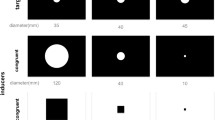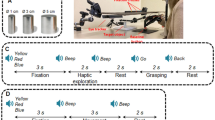Abstract
Object features (e.g. size, shape and orientation) are relevant for recognition and identification, but also for the control of manual actions. Converging evidence suggests a dissociation between the visual systems that mediate object perception and object-directed action. Here we present evidence suggesting that a similar dissociation might exist in the haptic domain. We demonstrate that a haptic variation of a size-contrast illusion influences the perceived size of a target object, but not the degree to which the hand is opened when that object is the target of a grasping movement. This finding is consistent with the view that object perception is "scene-based" and takes into consideration not only the size of the target object but also the sizes of other nearby objects. In contrast, the control of object-directed action is primarily driven by the absolute size of the target object independent of the relative sizes of other objects in the environment, suggesting a "actor-based" frame of reference. The present findings suggest that dissociations between action and perception are not unique to the visual system, but might instead reflect a general organizational principle of sensory processing.



Similar content being viewed by others
References
Aglioti S, DeSouza JF, Goodale MA (1995) Size-contrast illusions deceive the eye but not the hand. Curr Biol 5:679–685
Amedi A, Malach R, Hendler T, Peled S, Zohary E (2001) Visuo-haptic object-related activation in the ventral visual pathway. Nat Neurosci 4:324–330
Andersen RA, Snyder LH, Bradley DC, Xing J (1997) Multimodal representation of space in the posterior parietal cortex and its use in planning movements. Annu Rev Neurosci 20:303–330
Binkofski F, Dohle C, Posse S, Stephan KM, Hefter H, Seitz RJ, Freund HJ (1998) Human anterior intraparietal area subserves prehension: a combined lesion and functional MRI activation study. Neurology 50:1253–1259
Bridgeman B, Aiken W, Allen J, Maresh TC (1997) Influence of acoustic context on sound localization: an auditory Roelofs effect. Psychol Res 60:238–243
Flanagan JR, Beltzner MA (2000) Independence of perceptual and sensorimotor predictions in the size-weight illusion. Nat Neurosci 3:737–741
Franz VH (2001) Action does not resist visual illusions. Trends Cogn Sci 5:457–459
Franz VH, Gegenfurtner KR, Bulthoff HH, Fahle M (2000) Grasping visual illusions: no evidence for a dissociation between perception and action. Psychol Sci 11:20–25
Gentilucci M, Chieffi S, Deprati E, Saetti MC, Toni I (1996) Visual illusion and action. Neuropsychologia 34:369–376
Gentilucci M, Daprati E, Gangitano M (1998) Haptic information differentially interferes with visual analysis in reaching-grasping control and in perceptual processes. Neuroreport 9:887–891
Glover S (2002) Visual illusions affect planning but not control. Trends Cogn Sci 6:288–292
Glover S, Dixon P (2002) Dynamic effects of the Ebbinghaus illusion in grasping:support for a planning/control model of action. Percept Psychophys 64:266–278
Goodale MA, Haffenden A (1998) Frames of reference for perception and action in the human visual system. Neurosci Biobehav Rev 22:161–72
Goodale MA, Humphrey GK (1998) The objects of action and perception. Cognition 67:181–207
Goodale MA, Meenan JP, Bulthoff HH, Nicolle DA, Murphy KJ, Racicot CI (1994) Separate neural pathways for the visual analysis of object shape in perception and prehension. Curr Biol 4:604–610
Haffenden AM, Goodale MA (1998) The effect of pictorial illusion on prehension and perception. J Cogn Neurosci 10:122–136
Hu Y, Goodale MA (2000) Grasping after a delay shifts size-scaling from absolute to relative metrics. J Cogn Neurosci 12:856–868
Iwamura Y (1998) Hierarchical somatosensory processing. Curr Opin Neurobiol 8:522–528
James TW, Humphrey GK, Gati JS, Servos P, Menon RS, Goodale MA (2002) Haptic study of three-dimensional objects activates extrastriate visual areas. Neuropsychologia 40:1706–1714
Jeannerod M (1986) The formation of finger grip during prehension: a cortically mediated visuomotor pattern. Behav Brain Res 19:99–116
Kalaska JF, Scott SH, Cisek P, Sergio LE (1997) Cortical control of reaching movements. Curr Opin Neurobiol 7:849–859
Milner AD, Goodale MA (1995) The visual brain in action. Oxford University Press, New York
Pavani F, Boscagli I, Benvenuti F, Rabuffetti M, Farne A (1999) Are perception and action affected differently by the Titchener circles illusion? Exp Brain Res 127:95–101
Smeets JB, Brenner E (2001) Action beyond our grasp. Trends Cogn Sci 5:287
Smeets JBJ, Brenner E, de Grave DDJ, Cuijpers RH (2002) Illusions in action: consequences of inconsistent processing of spatial attributes. Exp Brain Res 147:135–144
Westwood DA, Heath M, Roy EA (2000) The effect of a pictorial illusion on closed-loop and open-loop prehension. Exp Brain Res 134:456–463
Author information
Authors and Affiliations
Corresponding author
Rights and permissions
About this article
Cite this article
Westwood, D.A., Goodale, M.A. A haptic size-contrast illusion affects size perception but not grasping. Exp Brain Res 153, 253–259 (2003). https://doi.org/10.1007/s00221-003-1599-x
Published:
Issue Date:
DOI: https://doi.org/10.1007/s00221-003-1599-x




